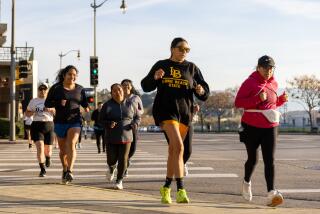In their own words, how runners, and maybe even ‘Brittany,’ found inspiration
The movie “Brittany Runs a Marathon” has charmed and moved audiences, not because the main character gets thinner and learns how to run long distances, but because, partly through running, the lead character learns to overcome her worst instincts and become a better person and friend — and, yes, a good runner. Author Michael Clinton has compiled similar tales of how running benefits people in ways large and small in his new book “Tales From the Trails: Runners’ Stories That Inspire and Transform.” Clinton, a longtime magazine executive in his 60s, has run almost his entire life, and is most proud of having run a marathon on each of the seven continents. Here’s what he had to say about his book and his motivation.
What led you to put together this book?
One of the things about runners is that they love to tell stories about their races, their injuries, their disappointments, their discoveries. Runners view running as more than just a physical act. They use running as their release, their therapy, getting rid of anxiety. There’s a lot of inspiration that comes off the conversations [you have] when you’re out having a run with friends.
In the movie, an overweight young woman starts running basically to lose weight. But by the time she is ready to run a marathon, her whole motivation for the race has changed. Do you find running to be full of surprises?
Absolutely. There’s a great story of a guy who was about 80 pounds overweight and an alcoholic, and he went to rehab. [H]e started using running as a form of transferring his addictions, ended up losing the weight and ran his first marathon. There’s another story of a young woman who was in her early 20s, and she couldn’t figure out why she was on an emotional roller coaster. She learned that she was going through menopause at the age of 24. She went out running with her sister and that led to a whole way for her to get her head around her health condition. She reveals, at the end of the story, that she has a baby, which is a great happy ending.
After 40-some years of doing this, what has running taught you?
I’ve learned to push my boundaries, mentally and physically. When I turned 60, I ran a marathon in Antarctica. I think what that taught me is that regardless of how we age, we have the capability to do many more things than we think we can.
Is there one thing that you can recommend to somebody who wants to run but is having a hard time getting out the front door?
What I always tell people who have never run is to go to a local high school and just go run around the track a couple of times and see how it feels. Then go run three or four times and see how that feels. Just keep building on it. ... [I]f you can run one mile, you can run three miles. If you can run four miles, you can run six. The build is phenomenal, and as people build, they get more self-confidence and more comfortable running, and before you know it, they’re planning their first 10K.
In some of the stories, people have used running to help get them through difficult challenges. What makes it so therapeutic?
Running creates a sort of mental process that allows you to sort through so many of the issues that you have in your life. Because when you’re running, you’re not distracted by kids or spouses or television or the internet. You’re out there on your own, and you’re kind of forced to think about things.
If you could run anywhere in the world, where would it be?
What I’m really intrigued with is a [Mt.] Everest run. You hike to the Everest base camp, and then you run down from there. I have a friend who did it. Now that I’ve run marathons in Mongolia and Antarctica, my attitude is sort of, “Bring it on.”
How long can you keep running marathons?
When I ran the London Marathon, there was a 100-year-old man running. So who knows? I think you just have to listen to your body. It’s not unusual for people to be running in their 70s and 80s. It’s the kind of exercise you can do for a lifetime.
More to Read
Sign up for The Wild
We’ll help you find the best places to hike, bike and run, as well as the perfect silent spots for meditation and yoga.
You may occasionally receive promotional content from the Los Angeles Times.










